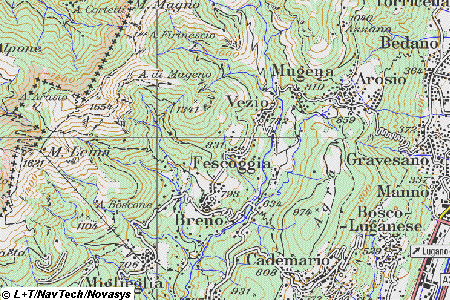Hiking the "Chestnut Trail" (adapted from a story by Dale Bechtel
for Swissinfo 2002)
For centuries, the chestnut tree was the tree of
life for the people of Ticino in southern Switzerland. Its story is told on the “chestnut trail,” the brainchild
of local forester Carlo Scheggia, who wants to see the chestnut tree regain some of the respect it once had.
The path
meanders along the peaceful mountain slopes of Ticino’s Malcantone region – which is only a chestnut’s throw
from the hectic streets of the city of Lugano.
 | Hikers are reminded of the time when
people living in the Ticino countryside lived on nothing but chestnuts for many months of the year. “The trees are privately
owned but the fields belong to the communities,” says Scheggia, who adds that the chestnut was known as the poor man’s
bread. “Each and every person needed the fruit from about 15 trees to feed himself for the six months when they depended
on the chestnut.”
Peter Lendi’s company, Erboristi Lendi, imports organic herbs and spices and produces
chestnut flour and pasta at a plant in the Malcantone village of Curio. As Lendi reaches into a large sack of dried chestnuts,
he explains that he has to import most of them because there simply aren’t enough harvested in Ticino to meet his needs.
Part of the reason, he says, is that the local people don’t want to be reminded of the past. “The older
generation doesn’t want to know anything about the chestnut because it brings back bad memories of poor times when they
had nothing to eat in winter but chestnuts. They don’t want to hear any more about chestnuts. They think we are crazy
when we tell them it is a very good food.”
So good in fact that the peasants never starved. The different native
varieties have few calories, are rich in protein and calcium and counterbalance fatty acids.
They also help people
with heart or circulation problems, and rheumatism sufferers. But because chestnuts are rich in carbohydrates, Lendi says
creativity is called for to make chestnut dishes that are not too rich. Gone are the days when most people in Ticino were
laborers, requiring a high-energy diet. Most of the 35 tons harvested annually in Ticino are sold fresh and roasted during
the chestnut festivals held each autumn in the canton.
Back on the trail, Scheggia explains that a chestnut is not
just a chestnut. There are about 15 different varieties native to the Malcantone region. “These different varieties
were an important part of the local people’s diet. There were kinds which ripened early or late, there were small and
large ones which were good dried or used as animal feed.” And traditionally, after St Martin’s day in mid-November,
goats were put out to graze in the chestnut groves. The fruit, leaves and shells had been gathered by this time.
The walk
takes about five hours. Hikers trample chestnuts underfoot as they pass through chestnut groves and quaint villages. The houses
in these villages are made of local stone and of course, chestnut wood. Surprisingly, there are no interpretive signposts
marking the way. “We didn’t want to pollute the countryside with signs. It doesn’t matter if someone taking
the trail doesn’t know everything there is to know about chestnuts by the end of the walk,” says Scheggia. “It’s
important that they enjoyed the walk, and that it awoke their senses. That is the most important thing.”
Scheggia
is often called upon to accompany school children on the trail. He says that he sits them down under one of the oldest, gnarled
and twisted trees and tells them a story. “They listen with wide open eyes. This is an important way to come into contact
with nature,” he says smiling.
“Not that we have to leave nature to itself. The chestnut tree was introduced
by man about 2,000 years ago, and the groves can only survive if we take care of them.”
|